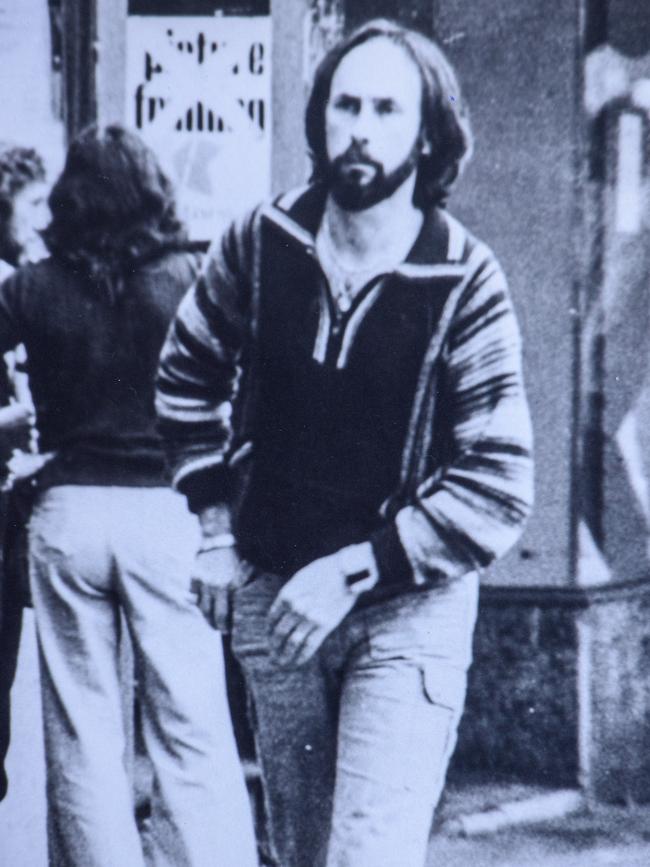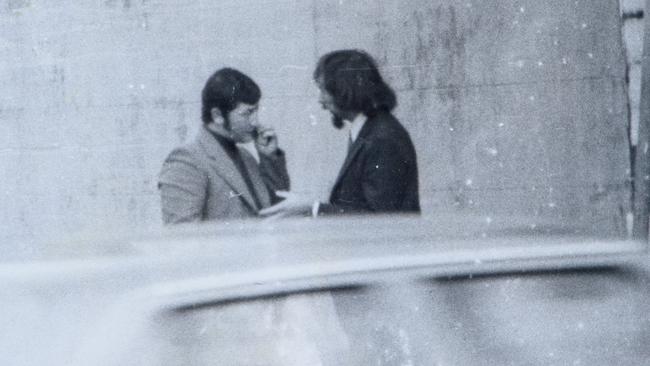Behind the Lines: Graeme Henderson the father of undercover policing
When Drug Squad detectives seized a thriving marijuana crop in the hills of Healesville in 1971, Graeme ‘Hondo’ Henderson left a note for the hapless crooks who’d grown it — and it would wind up in a bizarre location two years later.

Behind the Scenes
Don't miss out on the headlines from Behind the Scenes. Followed categories will be added to My News.
Geoff Wilkinson, One of Melbourne’s most decorated police and justice journalists, returns with a new weekly interview with the men and women of Victoria Police.
Graeme Henderson was not only the father of undercover policing in Victoria, but the father of the state’s youngest undercover operatives.
While other kids played cops and robbers during school holidays, or went to the movies, “Hondo’s” 13-year-old daughter and 10-year-old son were busy with the real thing.
“To consolidate my cover story, I had told people I was dealing with in the drug trade that I was separated from my wife and children and only saw my kids during holidays. On several occasions my children accompanied me to Fitzroy Street while I met with my contacts.
“The kids knew to refer to me as Alan Phillips, the name I’d adopted for my cover story.


Naturally, I made sure that the safety of the children was paramount.
“My undercover partner, Sen-Const. Rob Robertson, used a similar cover story regarding his children and marital status and it worked well.
“Rob’s previous Army service and my history as a wool classer meant we were both regarded as knockabout types and we complemented each other well. Rob used the name of Brian Wilson, a supposed heavy from NSW.
“Wilson acted as my minder, and I let if be known in the St Kilda scene that I was only interested in fencing property stolen by drug addicts and users. We had a good rapport with many of the prostitutes and drug users in Fitzroy, Collingwood and Footscray. Police command provided us with a flat in Clifton Hill to use as our address, and later we were given a VW Beetle by Mayne Nickless as part of our cover”.
Henderson, now 79, bald and bespectacled, joined the Victoria Police in 1962, when the force’s motto was still Tenez Le Droit. His own personal creed, he says, was to “treat everyone as you would expect your own parents to be treated”.
His first posting was to Sunshine, where his six-year stint included 12 months working Special Duties, where his haircut earned him the nickname The Beatle Cop.

In 1971, and by now known as Hondo, he was appointed to the Drug Squad, where he became so adept at changing his appearance that even his colleagues often failed to identify him on the street. The head of the squad, Insp Roy Kyte-Powell, had no objection to his new recruit working undercover.
The drugs of choice at the time were heroin, marijuana and LSD, and armed robberies on pharmacies throughout Melbourne were rife. Henderson recalls Drug Squad members being regularly called in by police from suburban stations with little knowledge of the drugs they had seized or the drug scene generally.
“The Drug Squad had only about 15 members. We had no access to computers and we were our own analysts.
“It was definitely a hippy scene, but becoming more dangerous. The Allen brothers and the Kenny family were just starting to make their presence felt”.
Henderson attended all four Sunbury Pop Festivals. The first, in 1971, was also attended by two NSW Drug Squad detectives, who were directed by Insp Kyle-Powell not to carry their firearms at the festival.
“That probably turned out to be lucky for me and them, because I was assaulted during the festival while trying to buy LSD from drug traffickers. I have no doubt that, if armed, the NSW members would have used their weapons”.
One of Henderson’s favourite stories from that period proved the value of both lateral thinking and a sense of humour in his line of work, when in 1971 Drug Squad detectives were tipped off about a thriving marijuana crop growing in the hills beyond Healesville.

“We located the crop and sat off it for days, but no one came near it. Due to manpower issues we couldn’t sustain any prolonged surveillance so we finished up having to pull up the crop, which was about 100 plants that were at least 1.5 metres tall.
“I left a note, saying: ‘To whom it may concern. Please contact Detective Henderson of the CIB Drug Bureau concerning your plants.” I also left a telephone number.
“Two years later we attended an address in Pickles Street, Port Melbourne, regarding a drug warrant and found a number of plants in the house and a hydroponic crop in the ceiling.
“We also found my letter to the offender whose crop we pulled back in 1971!”
Henderson was transferred in 1974 to the Licensing, Gaming and Vice Squad, where he clearly didn’t enjoy policing what he regarded as a draconian law which required him to buy alcohol from unlicensed restaurateurs — then charge them with “sly grogging”.
“It was a distasteful enforcement of the Act as I saw it,” he says while admitting to a liking for a good glass of red.
Henderson transferred in 1977 to the state’s new Bureau of Criminal Intelligence, where Assistant Commissioner Fred Silvester gave him “carte blanche” to operate undercover.

“Neither Rob Robertson or myself used drugs other than simulated smoking of marijuana, but we were able to maintain our credibility in the scene and I believe we were in the process of ‘climbing the tree’.
“We’d bought heroin from Douglas and Isobel Wilson, the Kiwi drug traffickers who were part of the Mr Asia gang, but they were murdered and their bodies found buried in a sandy grave at Rye in May, 1979.
While working for the BCI, Henderson and Robertson were briefed on a plot by some of Australia’s most notorious criminals, including Russell ‘Mad Dog’ Cox, to steal more than $1.5 million from a Mayne Nickless armoured van.
A rendezvous at Victoria Market to finalise details of the job turned ugly — and could have turned deadly — when a police car on a routine patrol appeared unexpectedly and spooked Cox, who produced a revolver but was persuaded by the quick-thinking Robertson not to shoot.
Robertson disarmed the sergeant and two policewomen, shoved them into a market dumpster, jammed the lid shut and threw their revolvers and police radio onto a nearby roof, while Cox — the most wanted man in Australia — fired a warning shot and fled into the night.
But that’s another story...
Henderson was awarded a Churchill Fellowship in 1978, to study undercover training and operations in San Francisco, Los Angeles, Chicago, Washington, New York, Montreal, Ottawa, London, Hong Kong, Thailand and Singapore.
An unexpected highlight, he said this week, was the night he went dancing with the wife of Canadian Prime Minister, Pierre Trudeau, who’d lost an election the previous day.
“I was in New York with some local detectives, and asked them if they could get me in to this notorious disco I’d heard so much about … Studio 54, where all the celebrities hung out.
“They got me in the back door and upstairs to where we walked through the door into a white mist. There were people lounging around on cushions, snorting coke and smoking dope like it was going out of fashion, and flashlights popping.
“When I asked the local detectives looking after me who all the photographers were following around they said it was Margaret Trudeau, so I decided to ask her for a dance.
“She knew I was an Aussie detective. We had a good chat, and three or four dances, until one of her Secret Service security detail decided I’d had enough, tapped me on the shoulder and told me to f--- off!”

Just as well the undercover cop from down under wasn’t known in New York, because Hondo’s cover would have been well and truly blown the next day when one of the happy snaps of him dancing with the PM’s wife appeared on the front page of the Post.
He said the then Chief Commissioner, Sinclair “Mick” Miller — himself a Churchill Fellow a decade earlier — encouraged him to apply, but when Henderson returned from his four-month voyage of discovery in August, 1979, he was promoted to Sen-Sgt with the Traffic Operations Group, which hardly seemed to make maximum use of his studies.
Neither did it help when he was involved in a serious motorcycle accident which hospitalised him for six months and put him off work for a total of 12 months.
But at least the setbacks gave him time to finish his Churchill Fellowship report and recommend some improvements to police undercover training.
When he recovered he submitted a proposal for a new undercover training program, which was approved by Deputy Commissioner John Frame and led Henderson to study the equivalent course in New Zealand. When he returned he produced Victoria’s first program,
The first person be signed up as a ‘role player’ in practical exercises within the course was, naturally, Sgt Rob Robertson, aka Brian Wilson.
Do you have a story for Geoff? Contact crime@heraldsun.com.au
MORE FROM GEOFF WILKINSON
